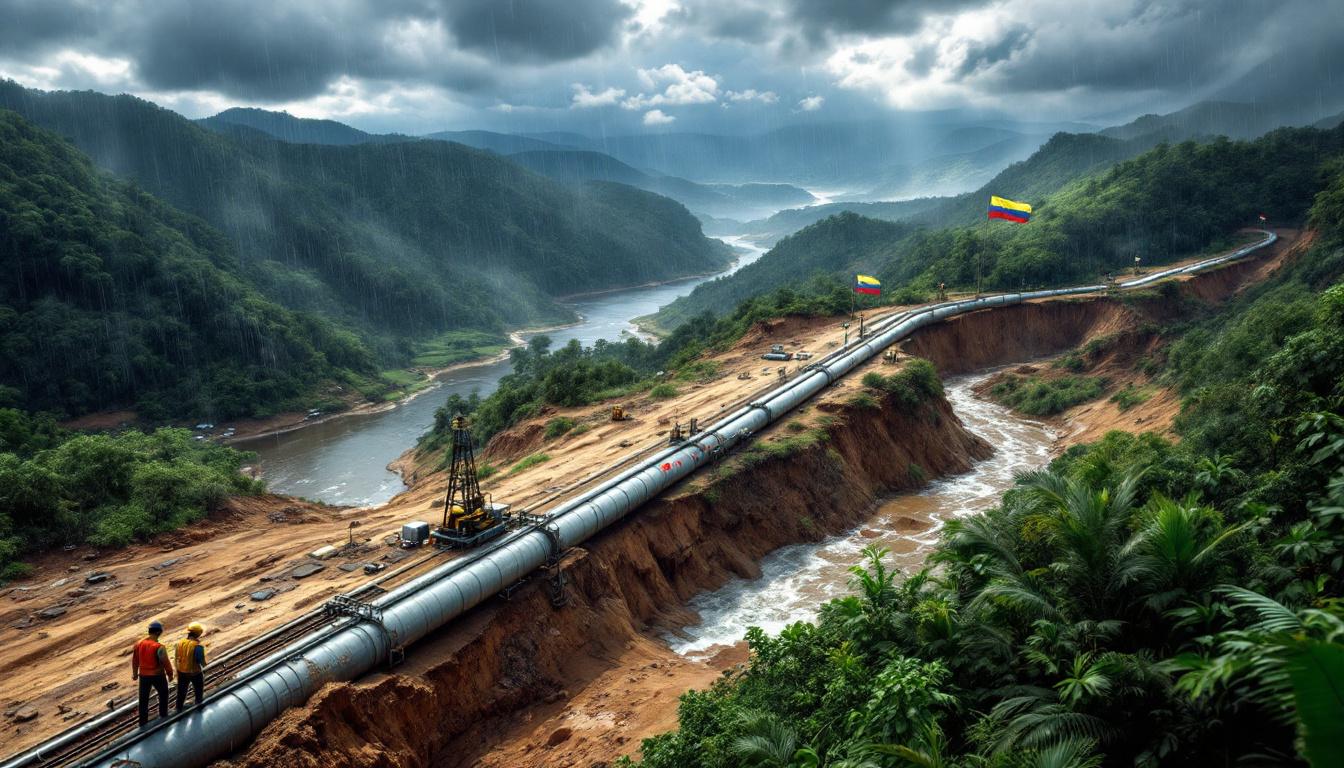Peru's Informal Mining Boom: Challenges to Copper Investment and Production
Peru, the world's third-largest copper producer, faces a growing crisis as informal mining operations expand across the country, threatening billions in investments and future production capacity. With rising concerns, many experts now reference the phenomenon of the informal mining boom in Peru, spurring debates on the future of the sector. In addition, industry analysts have noted a copper price prediction that may further impact investment decisions.
What is Driving Peru's Informal Mining Boom?
The Rise of Unauthorized Copper Operations
Peru's position as a global copper powerhouse is increasingly under threat from within. After slipping from second to third place in global production rankings, the country experienced its first copper production decline in five years during 2024, producing 2.74 million metric tons.
This decline coincides with the alarming growth of informal mining operations that encroach on legitimate concessions held by over 20 major mining companies, including Southern Copper, MMG, First Quantum, and Teck Resources. Consequently, observers worry that sustained high copper prices could further fuel the expansion.
Moreover, established players now debate how a copper investment strategies approach might counter the threat.
Economic and Social Factors Fueling Informal Mining
The economic appeal of informal mining is clear; it offers immediate income with minimal regulatory oversight. For many communities with limited formal employment opportunities, these operations serve as an accessible path to economic participation in Peru's mineral wealth.
Julia Torreblanca, President of the National Society of Mining, Petroleum and Energy (SNMPE), has noted that such operations represent the biggest fear among investors. This fear stems from production concerns, as well as from the complex social and security implications that informal mining creates.
Furthermore, as communities struggle with limited opportunities, the informal mining boom in Peru has become even more pronounced. In addition, technical reports and mineral exploration insights indicate that the economic gap between formal and informal sectors continues to widen.
How Does Informal Mining Threaten Peru's Copper Industry?
Investment Deterrence and Security Concerns
According to industry estimates, tens of billions of dollars in potential mining investments hang in the balance. Companies are now carefully evaluating the risks associated with Peru's growing informal mining sector.
The security challenges are particularly concerning, with criminal groups increasingly involved in unauthorized operations. Julia Torreblanca explained, "The biggest fear among investors is the increase in informal activity." Consequently, investment decisions are being re-evaluated, which could impede the growth required for the country to reach 3.4 million metric tons of copper production by decade's end.
Furthermore, legal issues arise as informal operations encroach upon formally granted territories, creating overlaps and significant security challenges. For instance, analysts have drawn attention to the emerging trend highlighted in a global copper supply forecast, reinforcing the need for swift regulatory action.
Production Impact and Global Standing
Peru's production decline in 2024 signals potential long-term consequences if informal activities persist. The nation's slip from the second to third rank in global copper production is a stark reminder of the risks. Experts predict that production could reach 3.4 million metric tons annually by 2030, but only if the challenge of informal mining is contained through rigorous enforcement and proper investment frameworks.
For a country where mining represents approximately 10% of GDP and 60% of exports, the stakes are high. Without decisive action, production and market position could continue to suffer. In addition, updated reports emphasise that structured investment opportunities insights are crucial for attracting the necessary capital.
What Regulatory Frameworks Exist for Mining in Peru?
The Controversial Reinfo Registry System
Peru's primary mechanism to address informal mining is the Reinfo registry, a temporary system that permits unauthorized miners to continue while aiming for eventual formalisation. Recently extended until December 31, 2025, this registry has sparked intense criticism from formal mining companies.
They argue that Reinfo acts as a cover for illegal activity rather than a genuine route to formalisation. Moreover, the registry allows operators to claim legitimacy even when continuing practices that may breach environmental regulations, labour laws, and safety standards.
In addition, some industry commentators point to a mining permits extension as a factor that further complicates the regulatory environment.
The Proposed MAPE Law
The Artisanal and Small-Scale Mining (MAPE) Law, currently under congressional review, is another attempted solution to Peru's informal mining crisis. However, many industry leaders have expressed concerns that it might inadvertently legitimise informal operations without providing sufficient compliance frameworks.
Julia Torreblanca has described the proposed law as "a big worry," arguing that without strict safeguards, the regulation could enable the unchecked growth of unauthorized mining activities. Consequently, while the law aspires to offer pathways for small-scale miners to operate within the legal framework, its ambiguous implementation details remain a topic of fierce debate.
How Does Informal Gold Mining Compare to Copper?
Lessons from Peru's Informal Gold Sector
Peru's informal gold sector provides a stark warning for copper. Currently, an estimated 40% of the country’s gold exports originate from informal mines. This staggering figure underlines the risks of an unregulated market, as evidenced by decades of environmental degradation and market instability.
While copper’s informal sector remains minimal compared with formal production, many government officials warn that prolonged high prices could spur a similar evolution. For instance, market analysts routinely refer to reports offering mineral exploration insights as evidence that this trend could eventually mirror gold’s trajectory.
Moreover, the environmental repercussions of informal gold mining—such as mercury contamination and deforestation—have been well documented. Although copper mining employs different methods, the absence of robust environmental controls in unauthorised operations remains a critical concern.
Property Rights and Land Use Conflicts
Encroachment by informal operators onto legally sanctioned territories creates serious challenges for property rights and investment security. Companies with valid concessions are frequently unable to exercise their full development rights due to unauthorised occupancy.
This dispute over land use introduces complex social dynamics, particularly as many informal operators hail from local communities with historical ties to the land. In addition, such conflicts highlight the need for policies that respect both legal rights and the socioeconomic realities of local populations.
To further understand these nuanced challenges, one may consult a recent community relations report that offers insights into balancing governance with local interests.
What Solutions Could Address Peru's Informal Mining Challenge?
Formalisation Pathways and Incentives
Effective solutions must address the economic drivers of informal mining while encouraging pathways to formalisation. Although the Reinfo registry offers temporary relief, real progress requires comprehensive support systems.
For instance, technical assistance programmes can help small-scale miners meet environmental and safety standards. Furthermore, accessible financing options could render compliance more economically viable for operations with limited capital.
Additionally, community engagement by formal mining companies can mitigate social factors. By establishing transparent benefit-sharing initiatives, the industry may reduce the appeal of informal alternatives. It is crucial to balance strict enforcement with viable economic incentives, ensuring sustainable growth while minimising risks associated with the informal mining boom in Peru.
Technological and Enforcement Approaches
Technological innovations hold significant promise for monitoring informal operations. Satellite monitoring and remote sensing, for example, can effectively detect unauthorised mining in remote areas. In addition, digital tracking systems could enhance transparency throughout the mineral supply chain.
Strengthening enforcement capabilities remains essential, especially in regions with limited state presence. Collaborative security initiatives between companies and government agencies have already demonstrated success in protecting legitimate concessions and mitigating criminal involvement.
In summary, finding a balance between growth and robust governance is critical for Peru's mining future. With decisive measures, industry stakeholders hope to address the informal mining boom in Peru, securing both environmental sustainability and economic prosperity.
FAQ: Peru's Informal Mining Sector
What is the difference between informal and illegal mining in Peru?
Informal mining in Peru refers to operations registered in the Reinfo system that are working toward formalisation, even if they have yet to fully meet all regulatory requirements. These operators enjoy temporary authorisation while progressing towards full legal compliance.
By contrast, illegal mining involves completely unauthorised operations that function entirely outside regulatory frameworks. Typically, these groups are linked with criminal activities and make no effort towards legalisation.
How does informal mining affect local communities?
Informal mining creates complex economic dependencies by providing immediate income, even if such operations lack the stability and benefits of formal employment.
Nevertheless, the environmental and health impacts can be severe. Without proper oversight, harmful practices may result in water contamination and unsafe working conditions, thereby affecting entire communities.
What role do international copper buyers play?
International copper buyers are beginning to face rigorous due diligence measures, especially under regulations like the EU's Conflict Minerals Regulation. In addition, supply chain transparency initiatives incentivise formalisation by ensuring that materials meet strict environmental and social standards.
Balancing Growth and Governance in Peru's Mining Future
Peru stands at a critical juncture in its mining development. With substantial copper reserves and a history of successful operations, the nation has enormous potential to bolster production and economic growth. However, addressing the challenges posed by the informal mining boom in Peru is essential.
Industry leaders predict that, with appropriate measures, production could rise to 3.4 million metric tons by 2030. Achieving this will require coordinated efforts among government, industry, local communities, and international partners. Furthermore, lessons from other countries and practical models underscore that effective formalisation is possible when economic incentives align with regulatory demands.
For investors and stakeholders alike, recognising the balance between growth and governance is paramount. As Julia Torreblanca famously remarked, informal mining has become the biggest fear among investors—a fear that must be managed to secure Peru's position as a leading copper producer.
In addition, balancing strict enforcement with support for small-scale operators creates opportunities that benefit the entire mineral sector. Consequently, a collaborative approach and continued vigilance will be key to realising the full potential of Peru’s mining future while mitigating risks linked to the informal mining boom in Peru.
Want to Discover the Next Major Mineral Opportunity?
Stay ahead of the market with real-time alerts on significant ASX mineral discoveries through Discovery Alert's proprietary Discovery IQ model, which transforms complex mining data into actionable investment insights. Explore why major mineral discoveries can lead to exceptional returns by visiting Discovery Alert's dedicated discoveries page and begin your 30-day free trial today.




